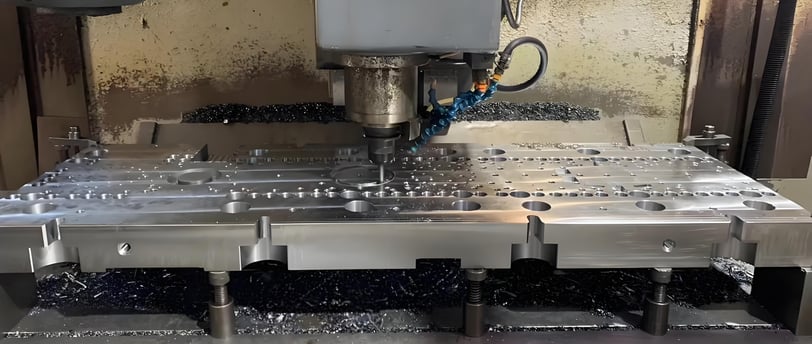How Can the Life of a Stamping Die Be Extended?
1/21/2025


Understanding Stamping Dies and Their Importance
Stamping dies are essential tools in the manufacturing sector, primarily used to shape and cut metal parts through a variety of processes. These dies function as molds that facilitate the high-volume production of complex metal shapes, significantly enhancing efficiency and precision in manufacturing. The process involves using a stamping press to apply force to the die, which in turn shapes the metal into desired forms. Stamping dies are vital in industries ranging from automotive to electronics, where precision and consistency are paramount.
There are several types of stamping dies, each serving distinct purposes in production. The most common types include simple dies, compound dies, and progressive dies. Simple dies cut a single shape from the metal stock, while compound dies can perform multiple operations, such as punching and cutting, in one stroke. Progressive dies, on the other hand, handle multiple tasks in a series of steps, allowing for continuous production without the need for manual intervention. The choice of die type significantly impacts the manufacturing process, as each type has specific benefits in terms of speed, complexity, and cost-effectiveness.
The effectiveness of a stamping die lies in its individual components. Key elements include punches, which pierce through the metal, and dies, which provide the counterforce necessary for shaping. Other parts such as guiding systems, strippers, and ejectors also play critical roles in ensuring smooth operation during the stamping process. Understanding these components is crucial as they determine not only the quality and efficiency of the production but also the longevity of the dies themselves. Therefore, recognizing the importance of stamping dies in manufacturing underscores the significance of maintaining and extending their lifespan, which will be elaborated upon in subsequent sections.
Common Factors That Lead to Die Wear and Tear
The performance and longevity of a stamping die can be compromised due to a variety of factors. Understanding these factors is essential for manufacturers aiming to optimize die life and mitigate deterioration. One of the foremost contributors to die wear and tear is the hardness of the material being utilized. Harder materials inherently apply more force on the die during operations, leading to accelerated wear. Additionally, the operational speed at which a die is used significantly influences its lifespan. Faster cycles may increase productivity but can also intensify the thermal and mechanical stresses on the die, resulting in an expedited degradation process.
The frequency of use is another critical factor. Stamping dies which are subjected to continuous and high-volume production experience a considerable amount of wear over time, eventually necessitating repair or replacement. The type of material being stamped further compounds this issue. For instance, materials with abrasive properties can lead to premature die wear, while softer materials may allow for a longer operational life due to reduced friction and stress levels during the stamping process.
In addition to these internal factors, external influences can also play a significant role in die wear. Environmental conditions such as humidity, temperature fluctuations, and the presence of contaminants can affect the performance of stamping dies. A well-maintained environment can prevent rust formation and other forms of corrosion that can hinder die integrity. Proper maintenance practices are crucial in extending the life of a stamping die. Regular inspections and timely interventions can prevent minor issues from escalating into major problems, thereby enhancing the overall durability of the die.
Best Practices for Extending the Life of Stamping Dies
To ensure the longevity of stamping dies, manufacturers must adopt a series of best practices that emphasize maintenance, monitoring, and technology. A well-structured regular maintenance schedule is fundamental. This schedule should include inspections and cleaning of dies, as dirt and debris can accelerate wear and tear. It is advisable to conduct these checks after a specified number of stamping cycles or at regular time intervals, depending on production demands.
Additionally, appropriate lubrication techniques play a significant role in die preservation. Using the right lubricant reduces friction between the die surfaces, thereby minimizing wear. It is essential to select lubricants that suit the specific materials being stamped, as compatibility directly influences the performance of the die.
Temperature control is another critical factor in extending the lifespan of stamping dies. Excess heat can lead to thermal fatigue, resulting in cracks or deformities. Manufacturers should monitor the operational temperatures closely and implement cooling systems if necessary, ensuring that dies operate within the recommended temperature range.
Choosing the right materials for stamping is equally important. Specific materials exhibit greater resistance to wear, while others may degrade more rapidly under stress. Therefore, assessing the material characteristics in conjunction with die requirements can significantly impact die longevity.
Moreover, tracking die performance and usage metrics offers valuable insights into die health. This data allows manufacturers to identify patterns or abnormalities that may indicate a need for maintenance or replacement. In addition, investing in staff training can lead to a more knowledgeable workforce adept in die maintenance practices, thereby preventing premature failures.
Finally, modern technologies such as predictive maintenance software and sensors can aid in monitoring die conditions in real-time. These technologies facilitate proactive measures, allowing for adjustments before issues arise, ultimately contributing to extending the life of stamping dies.
Investing in Quality and Upgrade Options for Stamping Dies
Investing in high-quality stamping dies is crucial for enhancing productivity and extending their lifespan. When determining the quality of stamping dies, several factors must be considered, including the material used, the design, and the manufacturing process. Stamping dies made from advanced, durable materials like high-speed steel or carbide can significantly improve longevity and reduce maintenance costs. By opting for such robust materials, manufacturers can experience fewer breakdowns and lower the need for frequent replacements, which ultimately leads to reduced long-term expenses.
Furthermore, upgrading existing stamping dies with modern technology can yield substantial benefits. Advanced die technologies, such as precision machining and CAD design, allow for greater accuracy and efficiency in operations. These upgrades can lead to a decrease in waste and a significant increase in production speed, thereby maximizing output. It is also essential to evaluate the costs associated with any potential upgrades. While initial investments may seem high, the long-term savings from enhanced efficiency and reduced downtime can justify the expense.
Customized solutions are another avenue worth exploring when investing in stamping dies. Tailoring dies to specific production needs can lead to higher efficiencies and an extended lifespan. For example, a company that adjusts their stamping die design to accommodate changes in material thickness may find they experience less wear and tear, prolonging the life of the die significantly. There are numerous case studies in the industry where businesses that invested in quality and technology saw improvements not only in efficiency but in overall operational effectiveness. These examples underscore the importance of thoughtful investment in durable stamping dies and the potential for remarkable returns on that investment.
